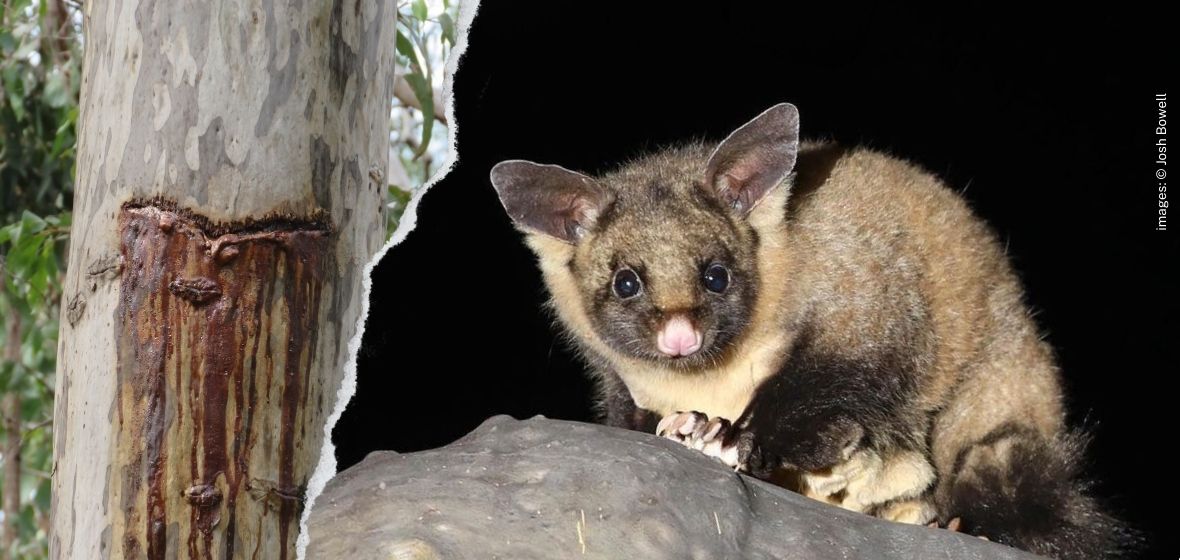
4 April 2024
Threatened yellow-bellied gliders have unique feeding habits, particularly in tapping tree sap. Recognising their feed trees can be a valuable tool for monitoring populations and understanding their behaviour.
Monitoring yellow-bellied glider populations
Yellow-bellied gliders are listed as endangered (Petaurus australis — Wet Tropics subspecies) and vulnerable (Petaurus australis australis — southern subspecies), both nationally and in Queensland. The species has a patchy distribution across a wide range of forest habitats throughout eastern Australia.
To assess yellow-bellied glider populations, researchers use various monitoring techniques. Due to the glider’s unique call, acoustic monitoring is frequently preferred over trapping techniques. This approach uses compact acoustic recording devices in potential yellow-bellied glider habitats to continuously monitor wildlife sounds.
Incisions created by yellow-bellied gliders while tapping tree sap have been identified as another valuable method of population monitoring, helping us understand their dietary preferences as well.
Different tree characteristics cause selective sap feeding
The yellow-bellied glider is quite specific in the resources it requires for survival, including the distribution of suitable-sized tree hollows, winter flowering eucalypts to provide nectar and pollen and eucalypt trees suitable for tapping sap. The species also requires trees with loose, shedding bark to forage for a range of insect prey. While they may consume a variety of foods, like insects and nectar, what intrigues scientists most are their habits for tapping tree sap.
Tapping tree sap is a crucial component of the yellow-bellied glider’s diet. They use their lower teeth to make incisions in the bark of several species of eucalypt trees and then lick up the sweet-tasting sap. The southern subspecies prefer various smooth-barked eucalypt trees, whereas the Wet Tropics subspecies feed exclusively on Eucalyptus resinifera.
These arboreal gliding mammals are highly selective of the trees used for sap feeding. Studies show they prefer trees that are larger, have wider crowns and occupy dominant canopy positions.
In addition, the characteristics of an individual tree, such as its sap flow or sap chemistry, influence whether gliders will be attracted to it for sap.
Additionally, yellow-bellied gliders will only use a single tree within a group of similar trees to tap sap, self-limiting their food supply. Tree selection may change over seasons and time, although an individual tree may be used for ten years or more.
How to recognise a feed tree
Trees incised by yellow-bellied gliders for tapping sap can be recognised by a series of gnawed incisions made into the bark of the trunk. These incisions are usually a distinctive shallow V-shape, typically 12cm in length, with an incised channel 1 to 5cm wide and up to 1cm deep.
Figure 1. Examples of incisions on feed trees © Wildlife Queensland
However, the shape, length, and depth of incisions may vary considerably depending on tree species and individual animals, with some incisions being flat-shaped and over 50cm long.
The glider makes two types of incisions in feed trees: one represents bouts of sap feeding, and the other represents the glider testing tree suitability.
Yellow-bellied Glider Project team spot hungry gliders
The Queensland Glider Network Yellow-bellied Glider Project team have been regularly checking a feed tree in Tamborine for some time, hoping to spot a yellow-bellied glider. Their vigilance was rewarded recently when they spotted two yellow-bellied gliders feasting on sap.
Josh Bowell captured these stunning photographs of the rare sighting.


Figure 2. Yellow-bellied gliders tapping tree sap. © Josh Bowell
“Given the yellow-bellied glider’s sensitivity to habitat disruption, we continue to monitor their distribution, particularly in developing areas of Queensland. It’s up to us all to safeguard these threatened marsupials and their feed trees,” says Wildlife Queensland Projects Manager Matt Cecil.
In summary, the yellow-bellied glider’s unique feeding habits and ability to recognise their feed trees provide valuable tools for monitoring populations and understanding their behaviour. However, continued logging and deforestation in Queensland pose significant threats to their habitat, emphasising the urgency of conservation efforts to safeguard this species and its ecosystem.
What you can do
- Email us if you’ve spotted a feed tree near you.
- Report your yellow-bellied glider sightings.
- Read about the Yellow-Bellied Glider Project.
- Subscribe to our eBulletin Talking Wildlife to learn more about your local wildlife, plus Wildlife Queensland’s latest news and offers.
Related articles
References:
- State of New South Wales (Department of Climate Change, Energy, the Environment and Water). (2004). Yellow-bellied glider feed trees. Retrieved from https://www.environment.nsw.gov.au/resources/nature/landholderNotes03YellowBelliedGlider.pdf
- Goldingay, R. (2015). Variation in sap feeding and tree testing by yellow-bellied gliders and the potential for population monitoring. Published by CSIRO Publishing on behalf of the Australian Mammal Society. Australian Mammalogy, 46. https://doi.org/10.1071/AM23025
- Mitchell, M. K., Rendall, A. R., Lefoe, M. J., & Whisson, D. A. (2023). Food tree selection by an arboreal marsupial: Implications for timber harvest. Forest Ecology and Management, Vol 544. Elsevier. https://doi.org/10.1016/j.foreco.2023.121218
- Wallis, I., & Goldingay, R. (2014). Does a sap feeding marsupial choose trees with specific chemical characteristics? Austral Ecology, 39(8), 973-983. https://doi.org/10.1111/aec.12167




